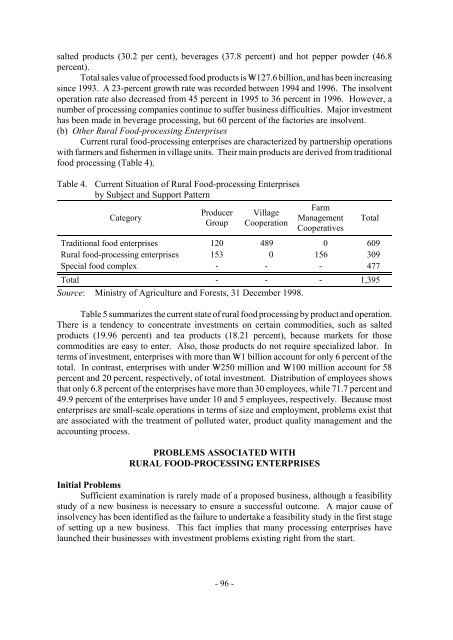Development of Agribusiness Enterprises - Asian Productivity ...
Development of Agribusiness Enterprises - Asian Productivity ...
Development of Agribusiness Enterprises - Asian Productivity ...
Create successful ePaper yourself
Turn your PDF publications into a flip-book with our unique Google optimized e-Paper software.
salted products (30.2 per cent), beverages (37.8 percent) and hot pepper powder (46.8<br />
percent).<br />
Total sales value <strong>of</strong> processed food products is W= 127.6 billion, and has been increasing<br />
since 1993. A 23-percent growth rate was recorded between 1994 and 1996. The insolvent<br />
operation rate also decreased from 45 percent in 1995 to 36 percent in 1996. However, a<br />
number <strong>of</strong> processing companies continue to suffer business difficulties. Major investment<br />
has been made in beverage processing, but 60 percent <strong>of</strong> the factories are insolvent.<br />
(b) Other Rural Food-processing <strong>Enterprises</strong><br />
Current rural food-processing enterprises are characterized by partnership operations<br />
with farmers and fishermen in village units. Their main products are derived from traditional<br />
food processing (Table 4).<br />
Table 4. Current Situation <strong>of</strong> Rural Food-processing <strong>Enterprises</strong><br />
by Subject and Support Pattern<br />
Category<br />
Producer<br />
Group<br />
- 96 -<br />
Village<br />
Cooperation<br />
Farm<br />
Management<br />
Cooperatives<br />
Total<br />
Traditional food enterprises 120 489 0 609<br />
Rural food-processing enterprises 153 0 156 309<br />
Special food complex - - - 477<br />
Total - - - 1,395<br />
Source: Ministry <strong>of</strong> Agriculture and Forests, 31 December 1998.<br />
Table 5 summarizes the current state <strong>of</strong> rural food processing by product and operation.<br />
There is a tendency to concentrate investments on certain commodities, such as salted<br />
products (19.96 percent) and tea products (18.21 percent), because markets for those<br />
commodities are easy to enter. Also, those products do not require specialized labor. In<br />
terms <strong>of</strong> investment, enterprises with more than W= 1 billion account for only 6 percent <strong>of</strong> the<br />
total. In contrast, enterprises with under W= 250 million and W= 100 million account for 58<br />
percent and 20 percent, respectively, <strong>of</strong> total investment. Distribution <strong>of</strong> employees shows<br />
that only 6.8 percent <strong>of</strong> the enterprises have more than 30 employees, while 71.7 percent and<br />
49.9 percent <strong>of</strong> the enterprises have under 10 and 5 employees, respectively. Because most<br />
enterprises are small-scale operations in terms <strong>of</strong> size and employment, problems exist that<br />
are associated with the treatment <strong>of</strong> polluted water, product quality management and the<br />
accounting process.<br />
PROBLEMS ASSOCIATED WITH<br />
RURAL FOOD-PROCESSING ENTERPRISES<br />
Initial Problems<br />
Sufficient examination is rarely made <strong>of</strong> a proposed business, although a feasibility<br />
study <strong>of</strong> a new business is necessary to ensure a successful outcome. A major cause <strong>of</strong><br />
insolvency has been identified as the failure to undertake a feasibility study in the first stage<br />
<strong>of</strong> setting up a new business. This fact implies that many processing enterprises have<br />
launched their businesses with investment problems existing right from the start.
















